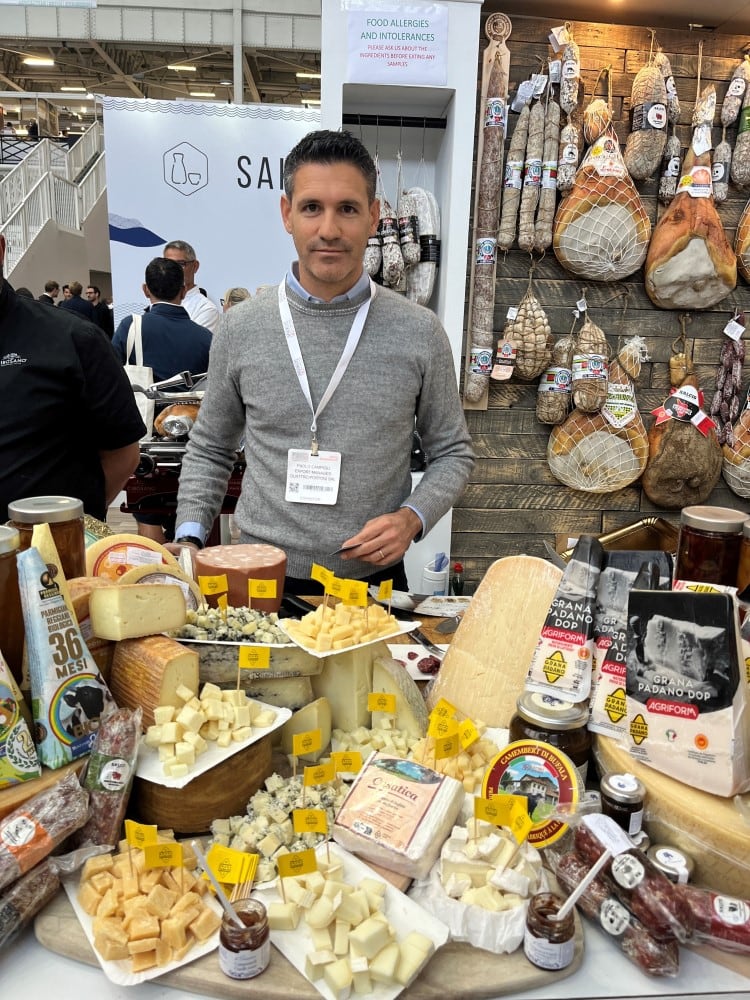Buffalo milk has twice as much fat and higher levels of lactose, minerals, and total solids compared to cow’s milk. Its composition makes it suitable for cheesemaking – with a 2022 study finding that buffalo milk yielded more fresh cheese than cow’s milk (22.5% vs 15.4%) due to the former’s greater fat content. Buffalo milk also firmed up quicker, the researchers found, making it more efficient to make cheese from it than cow’s milk.
Source: Composition and aptitude for cheese-making of milk from cows, buffaloes, goats, sheep, dromedary camels, and donkeys; https://doi.org/10.3168/jds.2021-20961
Last month, DairyReporter visited the Speciality & Fine Food Fair 2024 held at London Olympia to discover a swath of buffalo milk-based products on display – from artisanal cheeses to indulgent yogurt and egg-based desserts.
Showcased by Italian companies such as San Salvatore, Quattro Portoni and Defendi, we saw award-winning raw and aged cheeses – from a World Cheese Awards-winning blue-veined variety to Camembert – as well as yogurts and desserts for the hospitality and foodservice industry.
But while water buffalo milk products are more popular in the Mediterranean, in markets such as the UK, they are still a niche proposition (perhaps with the exception of buffalo mozzarella).

Speciality producers we spoke to at the show admitted as much – all stating they supply fromageries and artisanal stores rather than grocery majors. Paolo Campigli, commercial director at Quattro Portoni, said the UK market is still niche but there’s growing consumer acceptance towards buffalo milk products. This is in large part due to buffalo milk’s mild-to-sweet flavor profile, he told us.
This makes buffalo-based cheeses well-positioned to appeal where pungent varieties such as Stilton are failing to capture the Gen Z consumer cohort.
However, even Quattro Portoni – a producer of an award-winning Blu di Bufala among at least 10 other varieties – supplying the UK market for a decade (mostly London locations and some in Scotland) hasn’t yield a contract with a major grocery retailer.
This didn’t seem to perturbe Campigli, who insisted the cheeses’ appeal lie in their unique qualities – being made of 100% water buffalo milk, rather than a blend of different fresh milks – and the company’s position as one of Europe’s first players in the buffalo dairy space, the business originating in the 1950s before building up its farm of more than 1,000 water buffalos in the 2000s in the Bergamo region.
Defendi, another Bergamo-based cheesemaker who makes cheese from buffalo and mixed milk, has been offering its products in the UK through importer/distributor Cibosano. But there are similar barriers to growing its offering in the UK, as buffalo-based products have remained an artisanal store staple in 2024.
What is holding this category back from going mainstream?
On the surface, the UK consumers’ lack of exposure to buffalo-based dairy outside of buffalo mozzarella and the products’ availability in mostly artisanal or luxury grocery stores appears to be hindering growth.
There could also be opportunities in foodservice and upmarket grocery retail chains, as Stefano Giorgetti, business development manager at buffalo dairy producer La Dispensa di San Salvatore told us. The company – whose products are distributed by La Credenza in the UK – says it had innovated in the cremoso category with a range of flavored desserts suitable both for retail and the foodservice.
Made with milk from the company’s water buffalo farms, cremoso is a ganache-like pudding made of buffalo milk and cream that can delivers both as a dense but smooth dessert or can be used for cooking, e.g. as a cream in a cake.

San Salvatore’s premium range of cremoso is packaged in sealed reusable terracotta jars and comes in 10 flavors: Vanilla, Cocoa and Hazelnut, Cappuccino, Pistachio, Strawberry, Coconut, Caramel, Peanuts and Chocolate, Tiramisú, and Grandma’s Cream (a cinnamon-infused affair that contains egg yolk in addition to the buffalo milk and cream).
We asked how positioning the cremosis as both a premium dessert and a cooking ingredient is working out, given the products 120g net weight and premium price tag. Giorgetti told us that pricing is indeed around 2.5% higher than competitor products – but that the company was confident its approach of combining traceable ingredients (via a QR code on-pack), reusable packaging, and natural ingredients would be a winning formula in the long run. “We’ve achieved our biggest growth year on year by creating a different category in cremoso,” he told us.
San Salvatore also offers plain and fruit-on-the-bottom yogurts that have been well-received in the foodservice, particularly hotels offering premium yogurt and desserts at breakfast.
The cremosis are the company’s only retail-oriented product, Giorgetti added, with a jar set to be priced around £4-£5 (and similarly in Italy in euro-equivalent pricing). The company has secured a contract with luxury department store Harrods, where the cremosis will appear in the food hall from the start of 2025.




